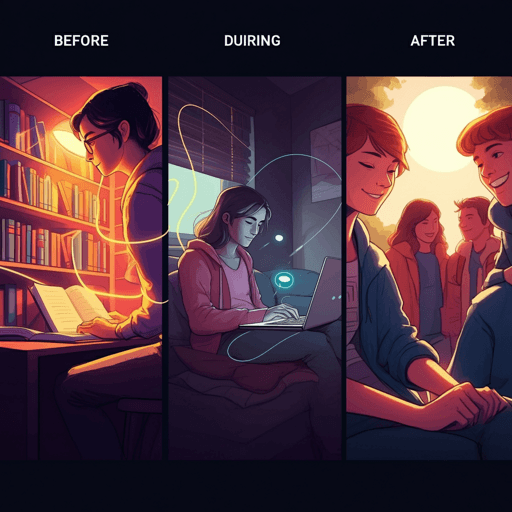
Psychology
Stress, Burnout and Study-Related Behavior in University Students: A Cross-Sectional Cohort Analysis Before, During, and After the COVID-19 Pandemic
V. Dresen, S. Staggl, et al.
During and after the COVID-19 pandemic, students experienced shifts in stress, burnout, study commitment, and coping: stress spiked during the pandemic then returned to pre-COVID levels, depression remained stable, cynicism and academic efficacy were lower in 2020, study commitment and active coping declined, emotional distancing peaked in 2020, and satisfaction with studies was highest post-pandemic. Research was conducted by Verena Dresen, Siegmund Staggl, Laura Fischer-Jbali, Markus Canazei, and Elisabeth Weiss.
~3 min • Beginner • English
Introduction
The study addresses how the COVID-19 pandemic influenced university students’ stress, burnout, and study-related behavior across time. Prior work shows high stress among students and increased stress during the pandemic, linked to remote learning challenges, social isolation, academic uncertainty, and other stressors. Burnout—characterized by emotional exhaustion, cynicism/depersonalization, and reduced efficacy—was prevalent among students even pre-pandemic, varying by discipline and country. Evidence regarding pandemic effects on burnout is mixed: many studies report increases, while some show decreases or no change, potentially influenced by field-specific factors (e.g., canceled internships). There is limited evidence on post-pandemic trajectories as institutions returned to in-person learning, with heterogeneous findings on whether burnout normalized or exceeded pre-pandemic levels. To provide a comprehensive view, the study simultaneously examines stress, depression, burnout, and study-related behavior (engagement, coping) before (2016), during (2020), and after (2024) the pandemic, using a student-adapted AVEM framework capturing study commitment, stress resilience, and emotional well-being.
Literature Review
The introduction synthesizes multiple meta-analyses and cross-national studies documenting elevated student stress during COVID-19 and substantial prevalence of burnout dimensions (emotional exhaustion, cynicism, reduced efficacy), with higher rates in low-income countries and in demanding disciplines (notably medicine). Prevalence estimates of academic burnout varied widely pre-pandemic across fields (16–56%). Cohort and longitudinal comparisons around COVID-19 often showed increased burnout, though some reported declines or no change, influenced by contextual factors (e.g., digital learning, canceled internships). Post-pandemic evidence remains sparse and mixed: some report improvements below pre-pandemic levels, others report higher burnout and lower engagement than pre-pandemic. Scholars recommend concurrent assessment of academic engagement and burnout; salutogenic models (AVEM) identify healthy, unambitious, and risk patterns, with pandemic-era shifts toward risk patterns. This study builds on these strands by comparing pre-, during-, and post-pandemic cohorts on stress, depression, burnout, and study-related behavior.
Methodology
Design: Cross-sectional cohort comparison of three student cohorts assessed during exam periods (June–July) in 2016 (pre-COVID-19), 2020 (COVID-19 onset), and 2024 (post-COVID-19). Participants: German-speaking students from various Austrian and German universities. Recruitment via social media, university courses, and the University of Innsbruck mailing list. Inclusion criterion: active university enrollment. Total respondents: 1126; excluded for incomplete data: 110; final N = 1016 (pre: n=364; COVID: n=350; post: n=302). Age range 18–49 years (M=23.82, SD=3.77). Ethics: Approved by University of Graz (GZ. 39/13/63 ex 2013/14; 17 Jan 2014) and University of Innsbruck (28/2020; 6 Jul 2020). Informed consent obtained.
Measures:
- CES-D-R15: 15-item depressive symptoms over past week, 0–3 scale; higher scores indicate greater depression; internal consistency α=0.87 in current study.
- PSS-10 (German): Perceived stress over past month, 0–4 scale; higher scores indicate greater stress; α=0.92.
- MBI-SS (German): 15 items across Emotional Exhaustion (5 items, α=0.87), Cynicism/Depersonalization (4 items, α=0.71), Academic Efficacy (6 items, α=0.79). Items rated 0–6 (never–daily). Burnout indicated by high exhaustion, high cynicism, low efficacy.
- Modified AVEM for students: 66 items; 11 subscales (6 items each; 1–5 Likert; max 30 per subscale). Domains: Study Commitment (Perceived Significance, Academic Goals/Ambition, Commitment, Striving for Perfection, Emotional Distancing), Stress Resilience (Tendency to Resignation, Active Coping, Balance/Emotional Stability; Emotional Distancing has dual loading), Emotional Well-Being (Satisfaction with Studies, Life Satisfaction, Perceived Social Support). Internal consistencies α=0.77–0.88.
Statistical analysis: Descriptives (means, SDs). Group differences in demographics via chi-square or Fisher’s exact tests; age via ANOVA. Due to age differences across cohorts, outcomes analyzed with ANCOVA/MANCOVAs controlling for age. Post hoc pairwise comparisons with Bonferroni correction. Effect sizes as partial eta-squared (ηp²). Alpha=0.05. Software: SPSS 26.
Key Findings
Sample characteristics: Significant cohort differences in age (F(2,1013)=20.829, p<0.001, ηp²=0.039), gender (p=0.009), additional job (χ²(2,N=1016)=38.585, p<0.001), level of education (χ²(4,N=964)=51.382, p<0.001), and university course (χ²(10,N=1016)=131.067, p<0.001). No differences in marital status or having children.
Stress and depression:
- PSS-10: Significant cohort effect (ANCOVA with age covariate: F(2,1012)=4.657, p=0.010, ηp²=0.009). COVID-19 cohort > pre-COVID-19 (p<0.001). No other pairwise differences. Means: pre 18.70 (SD 7.59), COVID 20.38 (7.57), post 19.57 (6.61).
- CES-D-R15: No cohort differences (F(2,1012)=1.181, p=0.307, ηp²=0.002). Means: pre 28.88 (9.37), COVID 29.97 (9.85), post 29.36 (8.82).
Burnout (MBI-SS): MANCOVA significant (F(6,2022)=11.867, p<0.001, ηp²=0.034). Univariate effects:
- Cynicism/Depersonalization: F(2,1012)=16.184, p<0.001, ηp²=0.031; COVID lower vs pre (p<0.001) and post (p=0.001); pre vs post ns (p=0.282). Means: pre 1.99 (1.42), COVID 1.41 (1.47), post 1.91 (1.52).
- Academic Efficacy: F(2,1012)=4.887, p=0.008, ηp²=0.010; pre > COVID (p=0.009); pre vs post trend (p=0.082); COVID vs post ns (p>1). Means: pre 3.81 (0.99), COVID 3.59 (1.00), post 3.66 (1.05).
- Emotional Exhaustion: trend F(2,1012)=2.873, p=0.057, ηp²=0.006; pre > COVID trend (p=0.051). Means: pre 2.73 (1.31), COVID 2.50 (1.35), post 2.66 (1.21).
AVEM Study Commitment domain: MANCOVA significant (F(10,2018)=11.297, p<0.001, ηp²=0.053). Univariate effects:
- Perceived Significance: F(2,1012)=5.667, p=0.004; COVID > post (p=0.017); pre > post (p=0.005); pre vs COVID ns. Means: pre 14.57 (4.85), COVID 14.45 (4.65), post 13.48 (4.42).
- Academic Goals/Ambition: F=19.425, p<0.001; COVID < pre (p<0.001); pre > post (p<0.001). Means: pre 21.37 (5.06), COVID 19.13 (4.77), post 19.52 (4.85).
- Commitment: F=22.177, p<0.001; COVID < pre (p<0.001); pre > post (p<0.001). Means: pre 18.50 (5.36), COVID 16.09 (5.45), post 16.52 (4.95).
- Striving for Perfection: F=35.967, p<0.001; COVID < pre (p<0.001) and < post (p=0.006); pre > post (p<0.001). Means: pre 21.57 (4.89), COVID 18.31 (5.44), post 19.72 (5.39).
- Emotional Distancing: F=5.247, p=0.005; COVID > pre (p=0.004); other contrasts ns. Means: pre 17.21 (5.37), COVID 18.46 (5.51), post 17.82 (4.88).
AVEM Resistance to Stress domain: MANCOVA significant (F(6,2022)=5.913, p<0.001, ηp²=0.017). Univariate:
- Active Coping: F(2,1012)=13.823, p<0.001; pre > COVID (p<0.001) and pre > post (p<0.001); COVID vs post ns (p=1). Means: pre 20.71 (4.43), COVID 19.40 (4.09), post 19.11 (4.23).
- Tendency to Resignation: ns (F=1.006, p=0.366). Means: pre 18.34 (5.00), COVID 18.29 (5.50), post 18.86 (4.51).
- Balance/Emotional Stability: ns (F=0.060, p=0.942). Means: pre 19.00 (5.01), COVID 19.03 (4.62), post 18.89 (4.06).
AVEM Emotional/Subjective Well-Being domain: MANCOVA significant (F(6,2022)=5.305, p<0.001, ηp²=0.015). Univariate:
- Satisfaction with Studies: F(2,1012)=13.418, p<0.001; pre < COVID (p=0.033) and pre < post (p<0.001); COVID < post (p=0.017). Means: pre 21.32 (4.68), COVID 22.19 (4.57), post 23.19 (4.48).
- Life Satisfaction: ns (F=0.129, p=0.879). Means ~20.5 across cohorts.
- Perceived Social Support: ns (F=0.020, p=0.980). Means ~23.1 across cohorts.
Discussion
The study shows that perceived stress peaked during the pandemic and subsequently returned to pre-pandemic levels, indicating adaptation as campuses reopened and routines normalized. In contrast, depression did not differ across cohorts, suggesting relative stability in depressive symptoms despite transient stress spikes. Burnout components revealed nuanced patterns: cynicism/depersonalization was lower during COVID-19 than before or after, possibly reflecting reduced academic pressures, increased flexibility from remote formats, or fewer competing demands (e.g., fewer part-time jobs). Academic efficacy was highest pre-pandemic and lower during and after COVID-19, implying persistent reductions in perceived accomplishment or competence amid altered learning conditions; disciplinary composition (more medical students pre-pandemic) may also have influenced efficacy. Emotional exhaustion differences were small and only trending.
Study-related behavior shifted meaningfully: study commitment (ambition, commitment, striving for perfection) declined during COVID-19 and remained lower post-pandemic relative to pre-pandemic, while emotional distancing peaked during COVID-19, consistent with disengagement as a coping strategy. Active coping was higher pre-pandemic and remained lower during and after COVID-19, indicating potential long-term changes in coping styles. Satisfaction with studies improved, being highest post-pandemic, likely due to restored in-person academic and social experiences, while life satisfaction and perceived social support were stable across cohorts. Collectively, findings address the research question by delineating differential temporal trajectories: stress normalized, but engagement and proactive coping show lingering alterations, underscoring lasting academic-behavioral impacts beyond the acute crisis.
Conclusion
Students’ stress, burnout, and study-related behavior fluctuated across pre-, during-, and post-pandemic cohorts. While perceived stress returned to pre-pandemic levels, academic engagement facets (ambition, commitment, striving for perfection) and active coping remained diminished relative to pre-COVID-19, and academic efficacy did not rebound to pre-pandemic levels. Satisfaction with studies was highest post-pandemic, reflecting the benefits of resumed in-person contexts. These results highlight persistent effects of the pandemic on students’ academic behavior and mental health. Institutions should implement long-term monitoring and targeted supports to rebuild engagement and strengthen effective coping, including accessible mental health services and learning environments that balance academic demands with well-being. Future research should employ longitudinal designs to track individual trajectories, disentangle disciplinary effects, and evaluate interventions that foster resilience and engagement.
Limitations
- Unequal distribution of academic disciplines across cohorts (higher proportion of medical students pre-COVID-19), potentially inflating pre-pandemic burnout/efficacy and limiting generalizability.
- Sample over-representation of psychology and social sciences/humanities students; mental health literacy and coping may differ from other disciplines.
- Cross-sectional cohort design precludes causal inference and within-person change assessment; longitudinal tracking is needed.
- Gender imbalance (majority female), with known sex/gender differences in stress and mental health that may affect outcomes.
- Cohort differences in employment status (part-time jobs) may confound burnout and stress outcomes.
Related Publications
Explore these studies to deepen your understanding of the subject.







